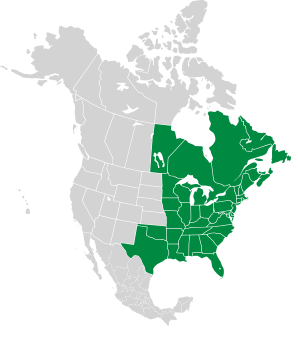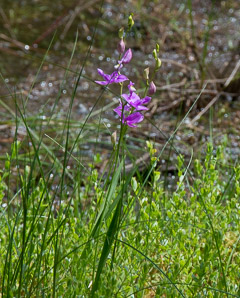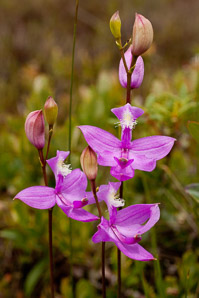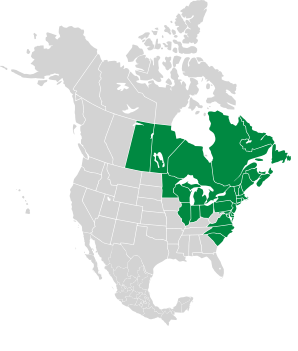
|
Calopogon tuberosus (L.) Britton, Sterns & Poggenb. Grass pink
The tuberous grass pink is an orchid native to eastern North America. Its range extends from eastern Canada all the way to the Caribbean. “Tuberous,” because the root is a ball-shaped corm; and “grass pink” for the grasslike single leaf, narrow like those of pinks. Grass pinks prefer bogs, fens, swamps, damp meadows, grasslands, and savannas. They are uncommon, and considered endangered in Illinois, Kentucky, and Maryland, New York, and Rhode Island. They are also also classified as rare in Vermont, Delaware, Virginia, West Virginia, Arkansas, Ohio, Missouri, Oklahoma, North Carolina, Georgia, Quebec, Manitoba, and Prince Edward Island. Look, but please don’t touch! Plants: Each plant consists of a single flowering stalk, up to 4′ (1.2 m) in height, accompanied by a single basal leaf. These are somewhat similar to Arethusa bulbosa (dragon’s mouth orchids), but tuberous grass pinks are taller, up to 4′ (1.2 m) vs. less than 1½′ (45 cm) tall. And the labellum, or lip, is uppermost, vs. lowermost on dragon’s mouth orchids. Both orchids are found in the same habitats, in the parts of their range that overlaps. Leaves: A single, basal leaf, narrow and linear in shape, is up to 1′ (38 cm) long and 1″ (2.5 cm) wide. Flowers: Flowers occur in groups (racemes) of 2-25 flowers, each 1-2″ (2.5-5 cm) wide. The fragrant flowers are light pink, magenta, or rarely, white. Like all orchids, they have bilateral symmetry—if you divide the flower vertically down the center, the halves are mirror images. Sepals are ⅜-⅞″ (1.2-2.5 cm) long, with a lobed labellum (lip) ⅜-⅞″ (1.1-2.3 cm) in length. The labellum is larger in proportion to the flower, as compared to other orchids. Flowers appear from May to July. Fruits: Oblong capsules up to ⅞″ (2.5 cm) long. Fruits appear from July to September. These similar species are found in similar habitats: |
6/18/2021 · Long Reach Preserve, Harpswell, Maine · By Priscilla Seimer 6/19/2021 · Long Reach Preserve, Harpswell, Maine 6/30/2011 · Corea Heath, Corea, Maine · By Susan Cole Kelly |
||||||||||||||||||||||||||||
|
| |||||||||||||||||||||||||||||
Arethusa bulbosa |
Pogonia ophioglossoides |
||||||||||||||||||||||||||||
|---|---|---|---|---|---|---|---|---|---|---|---|---|---|---|---|---|---|---|---|---|---|---|---|---|---|---|---|---|---|
| Common Name |  |
 |
|||||||||||||||||||||||||||
| Plant | Inconspicuous unless flowering, but flowers are showy and unique. At less than 1′ (40 cm) tall, smaller than similar orchids. And the labellum, or lip, is lowermost, vs. uppermost on grass pinks. | 1½-28″ (4-70 cm) tall, occurring sometimes in colonies. | |||||||||||||||||||||||||||
| Flowers | Each stem is 4-16″ (10-40 cm) long, and tipped by a single flower, rarely two. Each flower has three sepals on top, like rabbit ears, and two petals that form a hood. The sepals are ¾-2″ (2-5.5 cm) long. A colorful lower lip—the labellum—is ¾-1¼″ (1.9-3.5 cm) long, and white, with a yellow middle region and pink speckles, and some bristles in the center. Sepals and petals are pink to red, and rarely, white. Flowers appear from May to as late as mid-July, depending upon region. | One, rarely two, or very rarely three flowers top each stalk. Flowers are pink, or rarely white. The labellum, or lip, has jagged (lacerate) edges and a “beard” comprised of several rows of dark pink, yellow, or purple hairs. It is ⅜-⅞″ (1.2-2.5 cm) long. Sepals are ½-⅞″ (1.4-2.3 cm) long. There is an erect upper sepal, and two petals forming a hood. Flowers appear from June to August. | |||||||||||||||||||||||||||
| Leaves | A single, basal, grasslike leaf, 1½-8″ (4-20 cm) × ⅛-⅜″ (3-12 mm), typically develops after flowering. | A single clasping leaf appears midway up the stem. It is 1½-4″ (3.8-10 cm) × ¾″ (1.9 cm). | |||||||||||||||||||||||||||
| Fruit | An erect capsule, ¾-1¼″ (1.9-3.2 cm) long. | An erect capsule up to 1″ (2.5 cm) long. | |||||||||||||||||||||||||||
| Range/ Zones |
|
|
|||||||||||||||||||||||||||
| Habitats | Bogs, meadows, fens, and fields, and the edges of swamps and other wetlands. | Bogs, fens, prairies, meadows, woodlands, swamps, and along river or pond edges. | |||||||||||||||||||||||||||
| Type | Wild | Wild | |||||||||||||||||||||||||||
| Occurrence | Rare | Rare | |||||||||||||||||||||||||||
Online References:
The U.S. Forest Service Celebrating Wildflowers site
Goorchids.northamericanorchidcenter.org
References:
Clemants, Steven; Gracie, Carol, Wildflowers in the Field and Forest, Oxford University Press, 2006, p. 132
Calopogon tuberosus description by Thomas H. Kent, last updated 23 Sep 2021.
© FloraFinder.org. All rights reserved.
Range:







